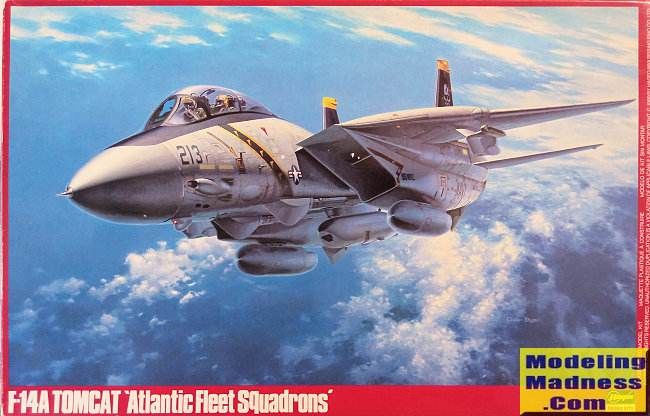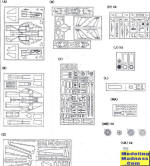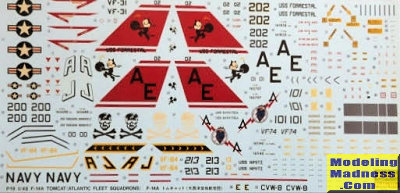Hasegawa 1/48 F-14A 'Atlantic Fleet Squadrons'
|
KIT #: |
07019 |
|
PRICE: |
$50.00 or so |
|
DECALS: |
Four options |
|
REVIEWER: |
Spiros
Pendedekas |
|
NOTES: |
|

The Grumman F-14 Tomcat is an American carrier-capable supersonic,
twin-engine, two-seat, twin-tail, all-weather-capable variable-sweep wing
fighter aircraft. The Tomcat was developed for the United States Navy's
Naval Fighter Experimental (VFX) program after the collapse of the General
Dynamics-Grumman F-111B project. A large and well equipped fighter, the F-14
was the first of the American Teen Series fighters, which were designed
incorporating air combat experience against MiG fighters during the Vietnam
War.
 Hasegawa
came in 1988 with their very nice F-14A, reboxing it more than 40 times ever
since and practically covering (with the occasional addition of some extra
parts) all Tomcat versions. The specific kit is the second (1989) reboxing,
bought in 2005 from one of my then de rigeur/sadly now closed Athens hobby
shop at what seemed a logical price.
Hasegawa
came in 1988 with their very nice F-14A, reboxing it more than 40 times ever
since and practically covering (with the occasional addition of some extra
parts) all Tomcat versions. The specific kit is the second (1989) reboxing,
bought in 2005 from one of my then de rigeur/sadly now closed Athens hobby
shop at what seemed a logical price.
The kit comes in a big top opening box of excellent quality, featuring a
supreme box art by Koike Shigeo, depicting VF-84 Jolly Rogers 161140/AJ 213
bird. Upon opening the box I was greeted with no less than 256 light gray
styrene parts arranged in 9 sprues, a clear sprue, a PE fret, white metal
rims and vinyl tires, all neatly packed. Molding is crisp with practically
no flash. General shapes of parts look correct, as do the finely recessed
panel lines.
Despite the kit's age and the presence of newer, more detailed offerings,
the cockpit is still adequately represented, including a good amount of key
elements found at the real thing. Instruments and switches are all over
raised and will look fine after some dry brushing, though it would have been
nice if Hasegawa have also provided instrument decals, since many of us like
to apply and make them succumb onto the raised instruments, yielding a very
realistic result. The seats look nice, as well, with molded-on seat belts.
Finally, two very nice pilots are provided and can be optionally attached.
Quite typically for an F-14 model, the fuselage is supplied in front and
rear sections, with the front section split vertically and the rear
horizontally. The wings feature separate flaps and slats and can be attached
either extended or retracted. The complex air intakes are well done, with
correct depth and with compressor faces attached at their end. The exhausts
are sufficiently done, including both “open” and “closed” nozzles.
The other key area of the landing gear is also well done, with relatively
busy looking gear legs and wheel bays. The wheel rims are nicely cast in
white metal (three styles for the main ones are provided, according to the
version built). The vinyl tires, though not liked by some, look realistic
and, since the rims are made of white metal, no danger of being eaten by the
vinyl tires exists.
As is the (not that favorable) norm for Hasegawa models, no other external
stores are provided apart from two external tanks and the TARPS pod and have
to be purchased separately.
Transparencies are well molded and crystal clear. The MA fret caters for the
canopy internal bracing, rear view mirrors and crew ladder. It is of the
stiffer stainless steel type, so maybe annealing it with some sort of heat
might sound a good idea, in order to make it more pliable.
Instructions are supremely done in typical Hasegawa style, this time in the
form of a 16 page booklet, containing a short history of the type, a sprues
map, with the construction spread in 40 clear and concise steps.
 Four
attractive schemes are provided, for a VF-31, a VF-74 and two VF-84 birds,
all in single light gray FS16440 shade. Decals are sharply printed,
featuring Hasegawa’s older trend to depict ”white” as “ivory”. Though old,
they look to be in excellent condition.
Four
attractive schemes are provided, for a VF-31, a VF-74 and two VF-84 birds,
all in single light gray FS16440 shade. Decals are sharply printed,
featuring Hasegawa’s older trend to depict ”white” as “ivory”. Though old,
they look to be in excellent condition.
Instructions want you to first assemble the cockpit with the nose bay
underneath, then trap them between the front fuselage halves. The nose gear
is supposed to be attached at this time, but I would wait until later
stages. The rear fuselage assembly follows, where you have to decide between
extended or retracted wings, in order to attach the correct wing glove seal.
Next is intakes assembly and installation, where some extra attention will
be required to get everything lined up correctly.
The exhausts are then assembled, where you can choose between opened or
closed nozzles, followed by the tail which contains the air brakes (you can
choose between deployed or retracted) and the arresting hook. Landing gear
is next, where you have to choose the correct main rims for your version,
followed by joining the front and rear fuselage section.
Stuff such as covers and antennas are then to be attached (where you can
choose to attach the boarding steps extended and construct the PE ladder
provided), followed by the canopy where its side internal bracing and rear
view mirrors are also provided as PE.
Next steps deal with assembly and installation of the wings, horizontal and
vertical stabilizers, followed by the external tanks, the TARPS pod and
stores’ pylons, ending a build that poses a good degree of complexity, which
makes it unsuitable for beginners.
Despite being 35 years old, this is still a very good kit of the iconic
Tomcat: general shapes of parts look correct, molding is crisp with finely
engraved panel lines, overall level of detail is sufficient, transparencies
are nicely done, instructions are clear and decals are well printed and
still in very good condition.
Out of the box, a very accurate Tomcat can emerge. As it is not an
easy build, the modeler has to take his time and plan ahead. Surely, as of
2024, there are newer kits that might offer more in terms of detail and
buildability, but, still, this one is definitely worth tackling.
Happy Modeling!
Spiros
PendedekasSeptember 2024
Copyright ModelingMadness.com. All rights reserved. No
reproduction in part or in whole without express permission from the editor.
If you would like your product reviewed fairly and fairly quickly, please
contact
the editor or see other details in the
Note to
Contributors.
Back to the Main Page
Back to the Review Index Page
Back to the Previews Index Page


 Hasegawa
came in 1988 with their very nice F-14A, reboxing it more than 40 times ever
since and practically covering (with the occasional addition of some extra
parts) all Tomcat versions. The specific kit is the second (1989) reboxing,
bought in 2005 from one of my then de rigeur/sadly now closed Athens hobby
shop at what seemed a logical price.
Hasegawa
came in 1988 with their very nice F-14A, reboxing it more than 40 times ever
since and practically covering (with the occasional addition of some extra
parts) all Tomcat versions. The specific kit is the second (1989) reboxing,
bought in 2005 from one of my then de rigeur/sadly now closed Athens hobby
shop at what seemed a logical price. Four
attractive schemes are provided, for a VF-31, a VF-74 and two VF-84 birds,
all in single light gray FS16440 shade. Decals are sharply printed,
featuring Hasegawa’s older trend to depict ”white” as “ivory”. Though old,
they look to be in excellent condition.
Four
attractive schemes are provided, for a VF-31, a VF-74 and two VF-84 birds,
all in single light gray FS16440 shade. Decals are sharply printed,
featuring Hasegawa’s older trend to depict ”white” as “ivory”. Though old,
they look to be in excellent condition.